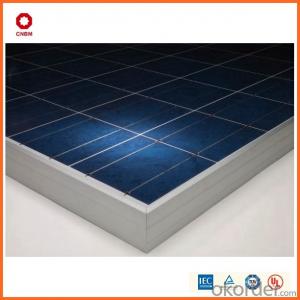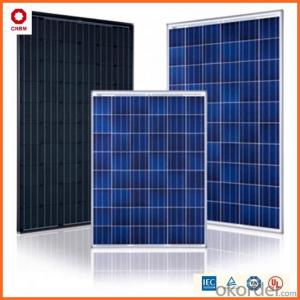65w Poly Small Solar Panels on Stock with Good Quality
- Loading Port:
- China main port
- Payment Terms:
- TT OR LC
- Min Order Qty:
- 1 watt
- Supply Capability:
- 10000000 watt/month
OKorder Service Pledge
OKorder Financial Service
You Might Also Like
Item specifice
Hot Sale !!! Quality and Safety of Small Poly Solar Panel 25~85w
1. Rigorous quality control meets the highest international standards.
2. High-transmissivity low-iron tempered glass, strong aluminium frame.
3. Using UV-resistant silicon.
4. IS09001/14001/CE/TUV/UL
Warranties of Small Poly Solar Panel 25~85w
1. 10 years limited product warranty
2. 15 years at 90% of the minimal rated power output
3. 25 years at 80% of the minimal rated power output
Specification
Characteristics of Poly solar panels CNBM (25-85W) | |||||
Max Power Voltage Vmp(V) | 30.3 | 30.8 | 31.1 | 31.4 | 31.85 |
Max Power Current Imp(A) | 7.60 | 7.64 | 7.73 | 7.81 | 7.85 |
Open Circuit Voltage Voc(V) | 36.1 | 36.6 | 37 | 37.3 | 37.68 |
Short Circuit Current Isc(A) | 8.50 | 8.55 | 8.65 | 8.75 | 8.85 |
Max Power Pm(W) | 230W | 235W | 240W | 245W | 250W |
Temperature Coefficient of Cells Poly solar panels CNBM (25-85W) | |
NOCT | 45± 2 |
Temperature Coeffucients of Isc | 0.0492 |
Temperature Coeffucients of Voc | -0.3374 |
Temperature Coeffucients of Voc | -0.4677 |
Mechanical Data of Poly solar panels CNBM (25-85W) | |
Dimension | 1638 × 982 × 40 mm |
Weight | 19.5 kg |
No. of Cells and Connections | 60 (6 ×10) |
Tolerance | 0 ~ + 5 W |
Cell | Monocrystalline Cell 156 × 156 mm |
Packing | 624 Pcs/40ft(H) Container |
Limits of Poly solar panels CNBM (25-85W) | |
Operating Temperature | -40 to +85 |
Storage Temperature | -40 to +85 |
Max System Voltage | 1000VDC(IEC) / 600VDC(UL) |
Features of our products:
• High conversion efficiency mono/poly-crystalline amorphous silicon solar cells
• Modules incorporate high performance bypass diodes to minimize the power drop caused by shading
• High transmittance, low-iron tempered glass
• High performance EVA encapsulant to prevent destroying and water.
• AI frame: without screw, corner connection. 8 holes on the frame can be installed easily
• Good performance of preventing from atrocious weather such as wind and hails
• Certifications: CE IEC TUV VDE UL, Class I
• 10 years 90% power output warranty

Shipping of Small Poly Solar Panel 25~85w
By Sea | Delivery from Shanghai or Ningbo seaport |
By Air | Departure from Shanghai Pudong Airport |
By Express | Post by DHL, EMS, UPS, TNT. |
- Q:Can solar energy systems be used for powering research laboratories or scientific facilities?
- Yes, solar energy systems can definitely be used for powering research laboratories or scientific facilities. In fact, solar energy is becoming increasingly popular in the scientific community due to its numerous benefits. Firstly, solar energy systems are highly reliable and require minimal maintenance. Once installed, they can provide a consistent and uninterrupted power supply to research laboratories or scientific facilities, ensuring that critical operations are not disrupted. This is particularly important for facilities that require continuous power, such as those conducting experiments or running sensitive equipment. Secondly, solar energy is a clean and renewable source of power. By utilizing solar energy systems, research laboratories and scientific facilities can significantly reduce their carbon footprint and contribute to the global effort of combating climate change. This aligns with the scientific community's commitment to sustainability and environmental responsibility. Furthermore, solar energy systems can also help reduce energy costs for research laboratories and scientific facilities. While the initial investment in installing solar panels may be higher, the long-term savings on electricity bills can be substantial. This frees up resources that can be directed towards other important research activities or equipment upgrades. It is also worth mentioning that advancements in solar technology have made it increasingly efficient and capable of generating power even in less sunny areas. This means that research laboratories and scientific facilities located in regions with varying weather conditions can still benefit from solar energy systems. In conclusion, solar energy systems are a viable and advantageous option for powering research laboratories or scientific facilities. They provide reliable, clean, and cost-effective energy, aligning with the sustainability goals of the scientific community. As solar technology continues to improve, it is expected that the use of solar energy in research facilities will become even more widespread.
- Q:Are there any risks of electrical short circuits with solar energy systems?
- Yes, there are risks of electrical short circuits with solar energy systems. Electrical short circuits can occur due to various factors such as faulty wiring, improper installation, or damaged components. These short circuits can lead to overheating, fire hazards, and potential damage to the solar panels or the entire system. It is crucial to ensure proper installation, regular maintenance, and compliance with electrical safety standards to minimize the risks of short circuits in solar energy systems.
- Q:How does temperature affect the efficiency of solar panels?
- Temperature affects the efficiency of solar panels by reducing their overall performance. As the temperature increases, the efficiency of solar panels decreases because the heat can cause the semiconductor material within the panel to have higher resistance, resulting in a reduced electrical output. This phenomenon, known as the temperature coefficient, varies depending on the type of solar panel technology being used.
- Q:Can solar energy systems be used for powering outdoor signage?
- Yes, solar energy systems can be used to power outdoor signage. Solar panels collect sunlight and convert it into electricity, which can then be used to power various electrical devices, including outdoor signage. This renewable energy source offers a sustainable and cost-effective solution for powering signage in areas where access to the electrical grid may be limited or expensive. Additionally, solar energy systems can help reduce carbon emissions and contribute to a greener environment.
- Q:Can solar energy systems be used for powering off-grid water treatment plants?
- Yes, solar energy systems can be used to power off-grid water treatment plants. Solar panels can be installed to generate electricity which can then be used to power the various components and equipment required for water treatment, such as pumps, filters, and disinfection systems. This provides a sustainable and environmentally-friendly solution for powering water treatment plants in remote and off-grid locations where access to the electrical grid is limited or non-existent.
- Q:What is the role of solar energy systems in reducing greenhouse gas emissions?
- Solar energy systems play a crucial role in reducing greenhouse gas emissions by harnessing the power of the sun to generate electricity without releasing any harmful pollutants or greenhouse gases into the environment. These systems provide a clean and renewable alternative to fossil fuel-based energy sources, such as coal or natural gas, which are major contributors to greenhouse gas emissions. By utilizing solar energy, we can significantly decrease our reliance on fossil fuels and mitigate the impact of climate change by reducing carbon dioxide and other greenhouse gas emissions.
- Q:Can solar energy systems be used in areas with limited access to solar energy equipment suppliers?
- Yes, solar energy systems can be used in areas with limited access to solar energy equipment suppliers. In such cases, it may require careful planning and resourcefulness to procure the necessary equipment, either by importing or seeking alternative suppliers. Additionally, local expertise and knowledge can be leveraged to design, install, and maintain solar energy systems in these areas, reducing reliance on external suppliers.
- Q:How do solar energy systems impact national energy policy?
- Solar energy systems have a significant impact on national energy policy by promoting a shift towards renewable energy sources and reducing dependence on fossil fuels. They encourage the adoption of sustainable practices and help countries meet their carbon emission reduction targets. Additionally, solar energy systems foster energy independence, create new job opportunities, and enhance energy security, ultimately shaping and influencing national energy policies.
- Q:What is the role of a solar energy system installer?
- The role of a solar energy system installer is to design, install, and maintain solar energy systems for residential, commercial, and industrial buildings. They play a crucial role in the transition towards renewable energy sources and are responsible for ensuring that solar panels are properly installed and functioning efficiently. Firstly, a solar energy system installer evaluates the site where the solar panels will be installed. They assess factors such as the location, orientation, and shading of the site to determine the optimal design and placement of the panels. This involves conducting a thorough analysis of the site's solar potential and considering any potential obstacles that may affect the system's performance. Once the design is finalized, the installer procures the necessary equipment and materials required for the installation. This includes solar panels, inverters, mounting systems, and electrical components. They also ensure compliance with local building codes and regulations. The installation process involves mounting the solar panels on rooftops or on the ground, connecting them to the electrical system of the building, and wiring them to the inverters. Installers must have a strong understanding of electrical systems to ensure safe and efficient connection of the solar panels. After the installation, solar energy system installers conduct thorough testing and commissioning to ensure that the system is functioning properly. This includes checking the electrical connections, monitoring system performance, and troubleshooting any issues that may arise. In addition to installation, solar energy system installers are also responsible for providing maintenance and repair services. They perform regular inspections, clean the panels, and replace any damaged or faulty components to ensure optimal performance and longevity of the system. They may also assist with system upgrades or expansions as needed. Overall, the role of a solar energy system installer is crucial in promoting the adoption of renewable energy. They are responsible for the successful installation and maintenance of solar energy systems, enabling individuals and businesses to reduce their reliance on fossil fuels and contribute to a more sustainable future.
- Q:Can solar energy systems be used in areas with limited access to solar charge controllers?
- Yes, solar energy systems can still be used in areas with limited access to solar charge controllers. While solar charge controllers are important for regulating and optimizing the charging of batteries in solar systems, there are alternative solutions that can be implemented. For example, manual charge controllers can be used where users manually monitor the battery charge level and disconnect the solar panels when necessary. Additionally, advanced battery management systems can be utilized to ensure efficient charging and protection of the batteries. Overall, although access to solar charge controllers may be limited, there are alternative methods to manage and utilize solar energy effectively in such areas.
1. Manufacturer Overview |
|
|---|---|
| Location | |
| Year Established | |
| Annual Output Value | |
| Main Markets | |
| Company Certifications | |
2. Manufacturer Certificates |
|
|---|---|
| a) Certification Name | |
| Range | |
| Reference | |
| Validity Period | |
3. Manufacturer Capability |
|
|---|---|
| a)Trade Capacity | |
| Nearest Port | |
| Export Percentage | |
| No.of Employees in Trade Department | |
| Language Spoken: | |
| b)Factory Information | |
| Factory Size: | |
| No. of Production Lines | |
| Contract Manufacturing | |
| Product Price Range | |
Send your message to us
65w Poly Small Solar Panels on Stock with Good Quality
- Loading Port:
- China main port
- Payment Terms:
- TT OR LC
- Min Order Qty:
- 1 watt
- Supply Capability:
- 10000000 watt/month
OKorder Service Pledge
OKorder Financial Service
Similar products
New products
Hot products
Related keywords






























